How to Change a Lawn Mower Blade: Easy Way
- March 4, 2024
- 3 comment
Maintaining your lawn mower is key to extending its lifespan and ensuring the health of your lawn. A vital component of this maintenance is the mower blade, which, when kept in good condition, ensures efficient cutting and promotes grass health.
Signs It’s Time to Change Your Blade
Dullness
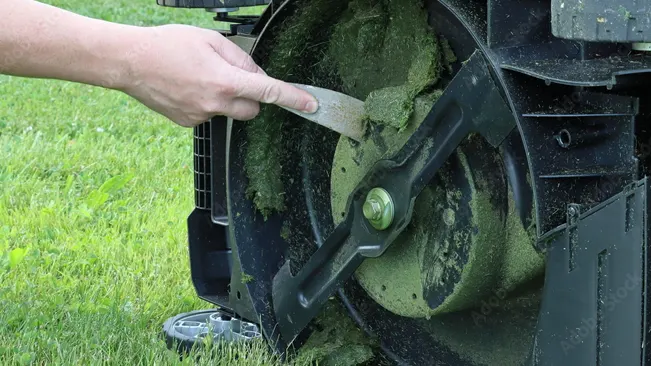
A sharp blade is key to a clean, efficient cut. When your blade becomes dull, it begins to tear the grass rather than slice it cleanly. This tearing can leave your lawn looking frayed and discolored, as torn grass tips brown more quickly. Additionally, torn grass is more susceptible to disease, as the jagged edges provide easy entry points for pathogens. If you notice your lawn looks less green and more ragged after mowing, it’s likely time to either sharpen or replace your lawn mower blade.
Bends or Dents

Physical damage to your lawn mower blade can occur from hitting rocks, large branches, or other hard objects hidden in your grass. Even minor bends, dents, or nicks in the blade can significantly impact its performance. A damaged blade can lead to uneven cuts, leaving your lawn looking patchy. In more severe cases, a bent blade can cause vibration in the mower, leading to wear and tear on its other components and potentially causing further damage. Regularly inspect your blade for any signs of physical damage, especially after mowing through a particularly rough patch of grass.
Rust and Corrosion
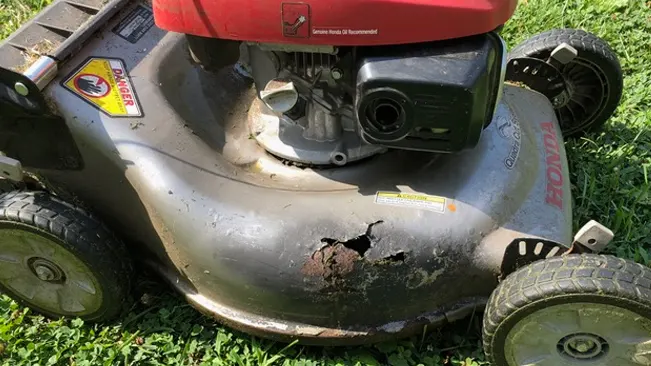
Blades are susceptible to rust and corrosion, especially if your lawn mower is stored outdoors or in a damp environment. Exposure to moisture, whether from dew, rain, or lawn watering, can accelerate the rusting process. Chemicals, such as fertilizers and pesticides applied to the lawn, can also contribute to corrosion. A rusted or corroded blade is weakened and may break or fail during use, posing a safety risk. Additionally, rust can dull the blade edge, compromising its cutting efficiency. Regularly check your blade for rust and corrosion, especially at the start and end of the mowing season, and consider replacing it if the damage is significant.
Tools and Materials Needed
- Wrench Set: You’ll need a set of wrenches to loosen and tighten the bolt that holds the lawn mower blade in place. The size of the wrench needed can vary depending on the mower model, so having a set with various sizes is beneficial.
- Protective Gloves: Sharp blades can cause injury, so it’s important to wear a sturdy pair of gloves to protect your hands during the removal and installation process. Gloves also provide a better grip on the tools and blade.
- Block of Wood: A block of wood is used to prevent the blade from turning while you’re loosening or tightening the bolt. This not only makes the task easier but also safer, as it prevents the blade from moving unexpectedly.
- Replacement Blade: Ensure you have the correct replacement blade for your specific lawn mower model. Using the wrong size or type of blade can damage your mower or result in poor cutting performance.
- Torque Wrench (Optional): For those who want to ensure the blade bolt is tightened to the manufacturer’s specifications, a torque wrench can be very useful. Over- or under-tightening the bolt can lead to issues, so a torque wrench can provide peace of mind.
- Blade Balancer (Optional): After sharpening a blade or before installing a new one, it’s a good idea to check its balance. An unbalanced blade can cause vibration, uneven wear on the mower, and a poor quality cut. A blade balancer is a simple tool that can help you ensure the blade’s weight is evenly distributed.
- Safety Glasses (Optional): While not always necessary, wearing safety glasses can protect your eyes from potential debris or sparks, especially if you’re also planning to sharpen the blade yourself.
Step-by-Step Guide to Changing Your Lawn Mower Blade
Preparing Your Mower
Before initiating any maintenance tasks on your lawn mower, prioritizing safety is paramount. Begin by positioning your mower on a level and stable surface to mitigate any potential movement during the blade changing process, thereby enhancing both your safety and the ease of the task. Additionally, it’s essential to drain the gas tank completely to avert the dangers of spillage or combustion. Given gasoline’s high flammability, even minor spills can present considerable hazards, particularly in confined spaces or in proximity to any sources of ignition.

The next crucial step in preparing your mower involves disconnecting the spark plug, a measure that ensures the mower cannot inadvertently start while you’re working on it. This precaution effectively eliminates the possibility of the engine activating unexpectedly, which could result in severe injuries. You can usually find the spark plug at the front part of the mower’s engine. To disconnect it, simply detach the plug wire, thereby ensuring a safe environment as you proceed with replacing the mower blade.
Removing the Old Blade
To safely remove the blade, you’ll need to prevent it from spinning. Insert a block of wood between the blade and the mower deck to immobilize the blade. This makeshift wedge will hold the blade firmly in place, allowing you to loosen the bolt without the blade spinning.
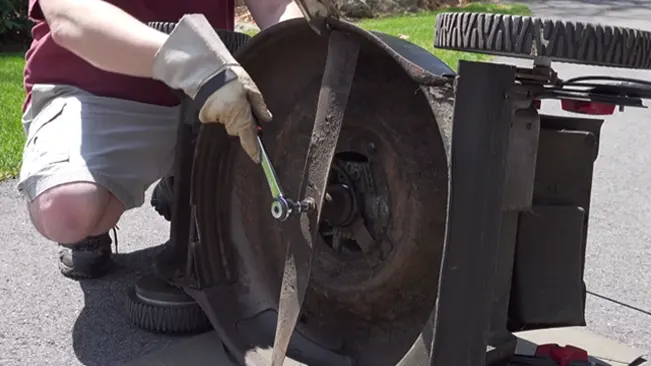
With the blade secured, use a wrench to loosen the bolt that holds the blade in place. This bolt is usually very tight, so some force may be required. Remember, the bolt is often threaded in the opposite direction to the blade’s rotation, so you might need to turn it clockwise to loosen it, contrary to the typical “lefty-loosey” rule.
Choosing the Right Replacement Blade
Not all blades are created equal, and using the wrong blade can damage your mower or result in poor cutting performance. Check your mower’s manual to find the specific blade type and size suited for your model. Lawn mower blades vary in length, width, and center hole shapes, so it’s essential to match the new blade exactly to the specifications of your mower.

Consider the type of cut you prefer (e.g., mulching, bagging, or discharging) as different blades are designed for different purposes. Ensure the replacement blade you choose is compatible with your mowing habits and lawn type.
Installing the New Blade
Position the new blade so that the cutting edges face away from the mower deck. Blades typically have a marking or stamp indicating the side that should face downward, towards the grass.

Hold the blade in place and thread the bolt by hand to ensure it’s properly aligned. Then, use your wrench to tighten the bolt securely. It’s crucial to achieve a firm fit to prevent the blade from wobbling or coming loose during operation. However, avoid overtightening, as this can strip the threads or make future removal difficult. Double-check the blade’s security by attempting to wiggle it with your hand (wearing gloves for safety). The blade should have no movement if properly installed.
Troubleshooting Common Issues
Uneven cuts often stem from issues with the lawn mower blade. If your lawn appears patchy or unevenly trimmed after mowing, it might be due to an improperly installed blade. Ensuring the blade is correctly positioned and securely fastened is crucial for a uniform cut. Additionally, a damaged blade, with nicks, bends, or dull edges, can also result in uneven cuts. Inspect the blade for any signs of wear or damage. If you find any, replacing the blade or having it professionally sharpened can resolve the issue and restore the quality of your lawn’s appearance.
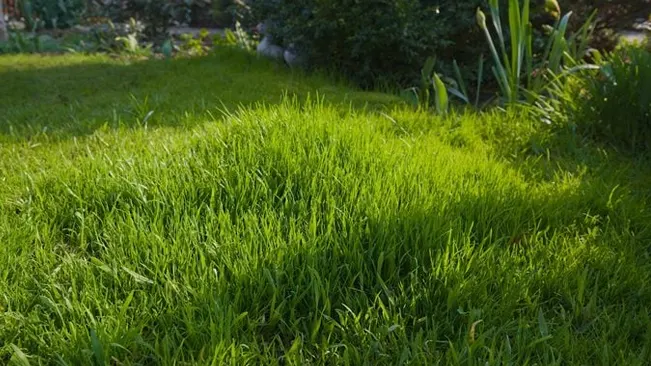
Excessive vibration during mowing is not only uncomfortable but can also indicate underlying problems with your mower. A common cause is an unbalanced blade. Over time, wear or damage to one side of the blade can throw it off balance, leading to significant vibration. Balancing the blade, either by sharpening the heavier side or replacing it if it’s too worn, can mitigate this issue. Another potential cause is a loose mounting bolt. If the bolt securing the blade to the mower isn’t tight enough, the blade can wobble, leading to vibrations. Checking and tightening the mounting bolt can often quickly resolve this problem, improving the mower’s performance and your comfort while using it.
Aftercare and Maintenance
Sharpening your new blade is a critical aspect of lawn mower maintenance. Over time, even the best blades can become dull from regular use, leading to less efficient cutting and potentially damaging your lawn. Regular sharpening can significantly extend the life of your blade, ensuring it delivers a clean, precise cut every time you mow. It’s generally recommended to sharpen your lawn mower blade at least once per mowing season, or more frequently if you notice signs of dullness or if your lawn has a lot of thick or coarse grass that can cause the blade to dull more quickly.
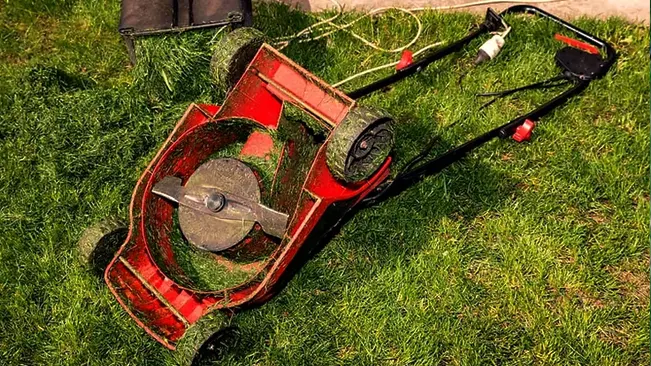
In addition to sharpening, conducting regular checks on your blade is vital for maintaining optimal cutting efficiency. Periodically inspect your blade for any signs of damage, such as nicks, bends, or rust. Dullness is another common issue that can arise with regular use. A dull blade tears the grass rather than cutting it cleanly, which can lead to an unhealthy lawn. By inspecting your blade regularly, you can identify when it’s time to sharpen or replace it, ensuring your mower always performs at its best and your lawn looks its best.
Conclusion
In conclusion, maintaining and replacing your lawn mower blade is a crucial aspect of lawn care that should not be overlooked. A sharp, well-maintained blade ensures efficient cutting, leading to a healthier, more attractive lawn. By recognizing the signs that it’s time to change your blade, such as dullness, damage, or excessive vibration, and by following the step-by-step guide to replace the blade, you can significantly improve your mowing experience. Regular aftercare, including blade sharpening and inspections, further extends the life of your blade and maintains the quality of your cuts. Adopting these maintenance practices will not only enhance the appearance of your lawn but also prolong the lifespan of your lawn mower, making it a worthwhile investment in the overall care of your outdoor space.
FAQs
- How often should I change my mower blade?
It depends on usage, but generally once a year or when you notice signs of wear. - Can I sharpen my mower blade instead of replacing it?
Yes, blades can be sharpened multiple times before needing replacement, depending on their condition. - What are the risks of using a dull blade?
Dull blades tear grass, leading to disease susceptibility and an unhealthy lawn. - How do I know the right blade size for my mower?
Refer to your mower’s manual or consult with a professional using your mower’s model number. - Is it necessary to balance the blade after installation?
Yes, an unbalanced blade can cause mower damage and uneven cuts.

Joel Cunningham
Forestry AuthorI'm Joel Cunningham, an expert in pruning and weed management with over a decade of experience. My skills are rooted in formal training and extensive practice, focusing on advanced pruning techniques and efficient weed control. I'm known for my quality work, precision, and deep understanding of plant health and soil dynamics. My contributions extend to educational initiatives where I share sustainable practices and advice, establishing myself as a reliable and authoritative figure in the gardening community.
3 comments
Whoever told you to turn a petrol mower on its side. Should only be tipped backwards to prevent oil going into exhaust and carburetor.
Paul
March 9, 2024 6:44 pmThank you Mr. Joel Cunningham I really appreciate your lesson and I really learn . I am a garden supervisor and this helps me alot...





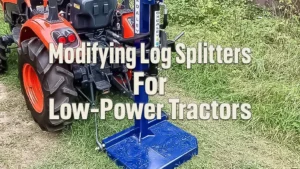







saya punya latihan memotong rumput gendong. Saya memotong ikut paras air disawah padi kemudian saya praktikkan di atas padang sekolah dan apa yang mereka kagumkan, mereka terlalu teruja dengan bakat yang saya lakukan. sebenarnya anda hanya perlukan latihan dan ianya akan menjadi satu kelebihan pada diri anda sendiri
Farid
March 15, 2024 5:22 am